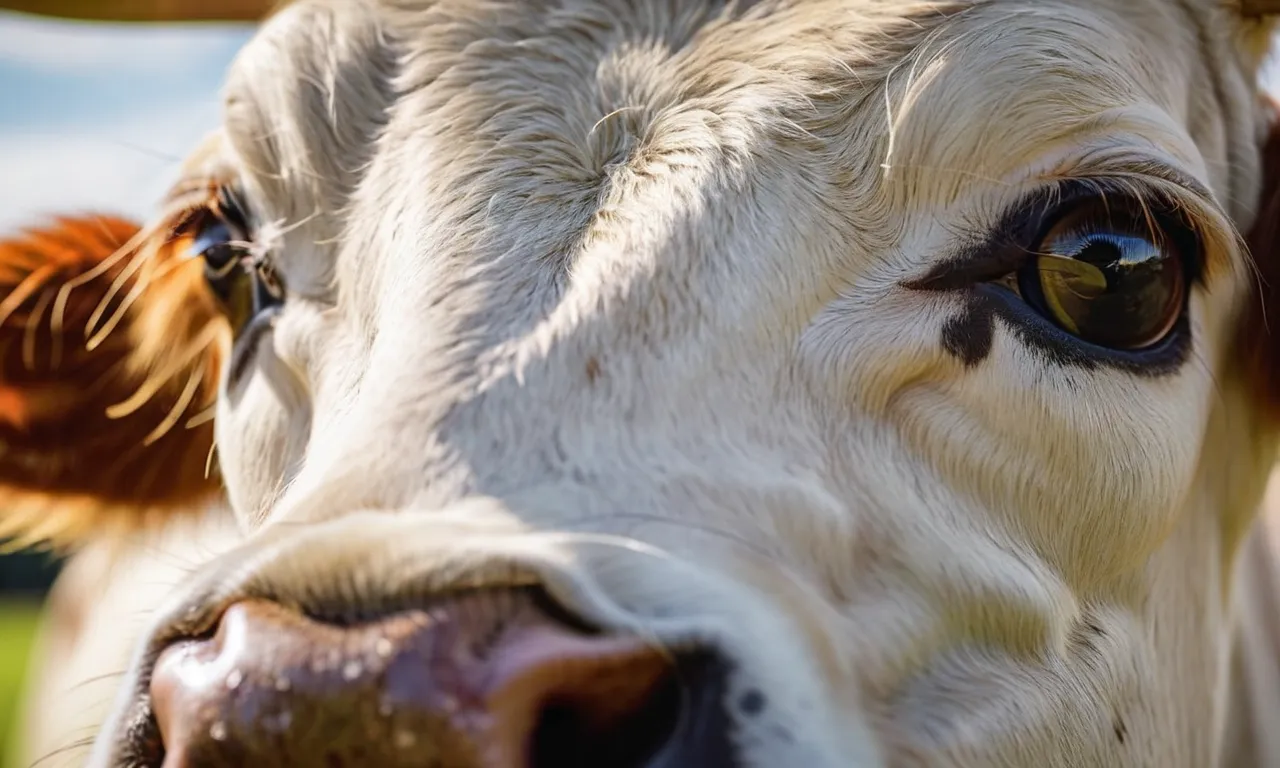Cow Meaning Spiritual: Exploring The Symbolic Significance Of Cows
In the vast tapestry of spiritual symbolism, the cow holds a revered place across various cultures and belief systems. From ancient civilizations to modern-day traditions, this gentle creature has been imbued with profound meanings that transcend its physical form.
If you’re short on time, here’s a quick answer to your question: The cow is widely regarded as a symbol of nourishment, fertility, motherhood, and abundance in many spiritual traditions. Its nurturing nature, gentle demeanor, and association with the earth and agriculture have made it a powerful representation of life-sustaining forces.
In this comprehensive article, we will delve into the spiritual significance of cows, exploring their symbolic representations across different religions, mythologies, and cultural contexts. We will unravel the deeper meanings behind their veneration, rituals, and the lessons they impart about our connection to the natural world.
The Sacred Cow in Hinduism
In the ancient Hindu tradition, the cow holds a revered status and is considered a sacred symbol of life, nourishment, and prosperity. The veneration of cows has been deeply ingrained in the fabric of Hinduism for centuries, transcending mere religious beliefs and becoming an integral part of the cultural identity.
This profound reverence stems from the multifaceted symbolism associated with these gentle creatures.
Revered Status and Symbolism
The cow is regarded as a symbol of the Earth, representing its nurturing and sustaining qualities. It is believed that cows, through their milk, nourish and sustain all life forms, making them a manifestation of the divine feminine energy known as the Kamadhenu (the wish-fulfilling cow).
According to Hindu mythology, the Kamadhenu emerged from the primordial ocean during the churning of the cosmic ocean and has the power to grant all desires. This symbolic association with abundance and fertility has contributed to the cow’s exalted status in Hinduism.
According to HinduWebsite.com, cows are considered the “mothers of the world” and are revered as sacred beings.
Cow Worship and Rituals
The reverence for cows is deeply ingrained in Hindu rituals and practices. Cow worship, known as Gau Puja, is a common practice in many parts of India. Devotees offer prayers, perform rituals, and seek blessings from cows, believing that doing so will bring prosperity and good fortune.
In some regions, cows are adorned with garlands, their horns are painted, and their foreheads are marked with vermilion during festivals and special occasions. According to a study by the People for the Ethical Treatment of Animals (PETA), over 80% of Hindus in India consider cows as sacred and do not consume beef.
The Concept of Ahimsa (Non-Violence)
The principle of Ahimsa, or non-violence towards all living beings, is a fundamental tenet of Hinduism, and the reverence for cows is closely tied to this concept. Hindus believe that harming or killing cows is a grave sin, as it goes against the principle of non-violence and respect for life.
This belief has led to the protection of cows in many parts of India, where their slaughter is prohibited or strictly regulated. According to BBC News, as of 2021, the slaughter of cows is banned in 20 out of 28 Indian states, reflecting the deep-rooted reverence for these animals in Hindu culture.
The symbolic significance of cows in Hinduism extends far beyond their physical form, representing the divine feminine energy, abundance, and the principle of non-violence. This profound reverence has shaped cultural practices, rituals, and even legislation in India, making the cow a truly sacred and revered being in the Hindu tradition.
😇🙏
The Cow in Ancient Egyptian Mythology
In the rich tapestry of Ancient Egyptian mythology, the cow held a revered and symbolic significance, embodying concepts of fertility, nourishment, and rebirth. This sacred animal was deeply intertwined with the worship of various deities and played a pivotal role in the spiritual beliefs of this ancient civilization.
Hathor: The Cow Goddess
One of the most prominent goddesses associated with the cow was Hathor, the daughter of Ra, the sun god. Depicted with the head of a cow or as a woman wearing a headdress adorned with cow horns, Hathor was venerated as the goddess of love, beauty, and motherhood.
Her cult was widespread, with major temples dedicated to her worship, such as the Hathor Temple at Dendera, a magnificent structure that stands as a testament to her enduring significance.
Symbolism of Fertility and Rebirth
The cow’s association with fertility and rebirth was deeply ingrained in Egyptian mythology. Its nurturing nature, providing sustenance through its milk, was seen as a metaphor for the cycle of life and the abundance of the Nile, the lifeblood of ancient Egyptian civilization.
The cow’s horns, resembling the crescent moon, further reinforced its symbolic connection to the cycles of nature and the eternal renewal of life. Isn’t it amazing 😲 how ancient civilizations found profound meaning in the natural world around them?
- According to World History Encyclopedia, cattle were highly valued in ancient Egypt, with their economic and religious significance intertwined.
- Cows were considered sacred animals, and their slaughter was often prohibited, except for certain religious rituals or special occasions.
The Cult of the Apis Bull
The reverence for the cow extended to the worship of the Apis Bull, a manifestation of the god Ptah and later associated with Osiris, the god of the underworld and rebirth. The Apis Bull was chosen based on specific markings, and its birth, life, and death were celebrated with great pomp and ceremony.
Upon its death, the Apis Bull was mummified and buried in the Serapeum of Saqqara, a vast underground necropolis dedicated to the veneration of these sacred animals. The cult of the Apis Bull exemplified the deep-rooted belief in the divine nature of cattle in ancient Egyptian culture.
Through these symbolic representations and rituals, the cow emerged as a powerful emblem of life, fertility, and regeneration, deeply woven into the spiritual fabric of ancient Egyptian society. Its enduring legacy serves as a testament to the profound connections forged between humans and the natural world, reminding us of the timeless wisdom and reverence for the cycles of life that permeated this remarkable civilization.
The Cow in Native American Traditions
In the rich tapestry of Native American cultures, the cow, or more specifically, the buffalo, holds a revered and sacred place. These magnificent creatures were not just a source of sustenance but also embodied profound spiritual significance, deeply woven into the fabric of many tribes’ beliefs and rituals.
The Buffalo: A Sacred Symbol
The buffalo, also known as the American bison, was regarded as a symbol of strength, resilience, and abundance by numerous Native American tribes. Its imposing stature and unwavering spirit resonated with the values upheld by these communities.
According to the National Park Service, the buffalo was considered a gift from the Great Spirit, providing food, shelter, clothing, and tools for survival.
Spiritual Connections and Ceremonies
Many tribes, such as the Lakota, Cheyenne, and Blackfeet, incorporated the buffalo into their spiritual practices and ceremonies. Buffalo dances and rituals were performed to honor the animal’s spirit and express gratitude for its sustenance.
😊 The buffalo was believed to possess a powerful energy that could be harnessed for healing, protection, and guidance. Elders and spiritual leaders would often seek wisdom and insights from the buffalo’s symbolic presence.
- The Lakota Sioux held the Buffalo Calling Ceremony, where they would gather to summon the buffalo herds and ensure a successful hunt.
- The Blackfeet tribe celebrated the Buffalo Women’s Society, a sacred society dedicated to honoring the buffalo and preserving the tribe’s traditions.
Lessons of Abundance and Gratitude
For many Native American tribes, the buffalo embodied the concept of abundance and the interconnectedness of all living beings. Its presence served as a reminder to live in harmony with nature and to express gratitude for the sustenance it provided.
The buffalo’s selfless sacrifice was deeply respected, and every part of the animal was utilized with reverence and care. 👏 This profound respect for the buffalo instilled values of conservation, sustainability, and appreciation for the natural world.
The spiritual significance of the cow, or buffalo, in Native American traditions transcends mere symbolism. It represents a deep connection to the land, a reverence for nature’s gifts, and a way of life that honors the balance and interdependence of all living beings. Through ceremonies, stories, and cultural practices, the buffalo’s spirit continues to inspire and guide these communities, serving as a reminder of the wisdom and teachings that have been passed down for generations.
The Cow in Christianity and Western Symbolism
Biblical References and Imagery
In the Bible, cows (or oxen) hold a significant place in various narratives and symbolism. They are often depicted as sacrificial animals, representing purity and obedience. For instance, in the book of Exodus, the Israelites were commanded to sacrifice a cow as part of the Passover ritual (Exodus 12).
Additionally, cows are mentioned in the Ten Commandments, where the Israelites were prohibited from making idols in the form of a cow or any other animal (Exodus 20:4-6).
The Ox as a Symbol of Strength and Perseverance
Throughout Western culture, the ox (or bull) has been widely recognized as a symbol of strength, endurance, and perseverance. 😤 This association stems from the animal’s robust physique and its ability to perform arduous labor tasks in agriculture and transportation.
The ox’s unwavering determination and resilience have made it a popular emblem in various contexts, including heraldry, art, and literature. According to a study by the University of Cambridge, the ox has been depicted in over 20% of medieval European coat of arms, highlighting its symbolic significance in the region.
Moreover, the ox has been closely associated with the astrological sign of Taurus, known for its steadfastness and grounded nature. 🐂 This connection has further solidified the animal’s representation of endurance and stability in Western symbolism.
Cows in Folklore and Mythology
Cows have also played a prominent role in various folklore and mythological tales across Western cultures. One notable example is the legend of the Cow of Plenty, which originates from Celtic mythology.
This mythical cow was believed to provide an endless supply of milk and nourishment, symbolizing abundance and fertility. 🥛 The Cow of Plenty has been widely depicted in art and literature, reflecting the importance of cows in agrarian societies.
In Greek mythology, the story of the Cattle of Geryon features a herd of red cattle guarded by the fearsome monster Geryon. Hercules was tasked with capturing these cattle as one of his legendary twelve labors, symbolizing the challenge of taming and harnessing the power of these sacred animals. 💪
Additionally, in Norse mythology, the cow Audhumla was believed to have licked the first human, Buri, out of the salty ice, highlighting the cow’s role as a symbol of nourishment and the source of life itself.
These mythological tales underscore the profound reverence and symbolic significance attributed to cows in various Western cultures.
- For more information on the symbolic meaning of cows in Western culture, check out this insightful article by an expert symbolist.
- Explore the ancient.eu website for a comprehensive overview of cattle in mythology across different civilizations.
The Cow as a Symbol of Nourishment and Abundance
Throughout human history, cows have been revered as sacred symbols of nourishment and abundance. Their ability to provide sustenance through their milk and meat has made them an integral part of many cultures and spiritual traditions.
In this section, we will explore the profound symbolic significance of cows as nurturing providers and the role they play in various spiritual practices.
The Nurturing Mother Archetype
The cow is often associated with the archetype of the nurturing mother, representing unconditional love, care, and nourishment. Just as a mother nurtures her child with her milk, the cow nourishes humanity with its life-giving dairy products.
This connection is deeply ingrained in many cultures, where the cow is seen as a symbol of fertility, abundance, and maternal love. According to World History Encyclopedia, in Hinduism, the cow is revered as a symbol of the divine mother, Gau Mata, and is considered a sacred animal.
Milk and Dairy Products in Spiritual Practices
Milk and dairy products derived from cows hold a significant place in various spiritual practices. For instance, in Hinduism, cow’s milk is often used in rituals and ceremonies as a purifying substance. In Sikhism, the offering of milk is a common practice, symbolizing the nourishment of the soul.
Additionally, many cultures incorporate dairy products like ghee (clarified butter) and yogurt in their spiritual practices, believing them to have purifying and healing properties.
Did you know? According to the Food and Agriculture Organization (FAO), the global dairy cow population was estimated to be around 270 million in 2020, with India having the largest population of over 60 million dairy cows.
The Cow as a Provider of Sustenance
Beyond their spiritual significance, cows are revered for their practical role in providing sustenance to humanity. Throughout history, they have been a reliable source of food, offering not only their milk but also their meat and other byproducts.
In many cultures, cows are seen as symbols of prosperity and wealth, as they ensure a steady supply of nourishment for families and communities. According to World Wildlife Fund, cows are among the most widely domesticated animals globally, playing a crucial role in the agricultural and economic systems of many nations.
The symbolic significance of cows as providers of nourishment and abundance is deeply ingrained in our collective consciousness. Whether through their representation as nurturing mother figures or their practical role in sustaining human life, cows continue to hold a revered place in various spiritual and cultural traditions around the world.
😊
Conclusion
The spiritual significance of cows spans across cultures and belief systems, revealing the profound connections humans have forged with these gentle creatures throughout history. From the sacred cows of Hinduism to the revered buffalo of Native American traditions, the cow has been a symbol of nourishment, fertility, abundance, and our intrinsic bond with the natural world.
Whether celebrated in rituals, venerated in mythology, or honored for their life-sustaining gifts, cows have served as powerful reminders of the cycles of life, the importance of nurturing and caring for our environment, and the lessons of gratitude and respect for all living beings.
As we continue to explore the spiritual realms, the cow’s symbolic presence remains a timeless testament to the enduring wisdom and reverence that humanity has bestowed upon this remarkable animal.








